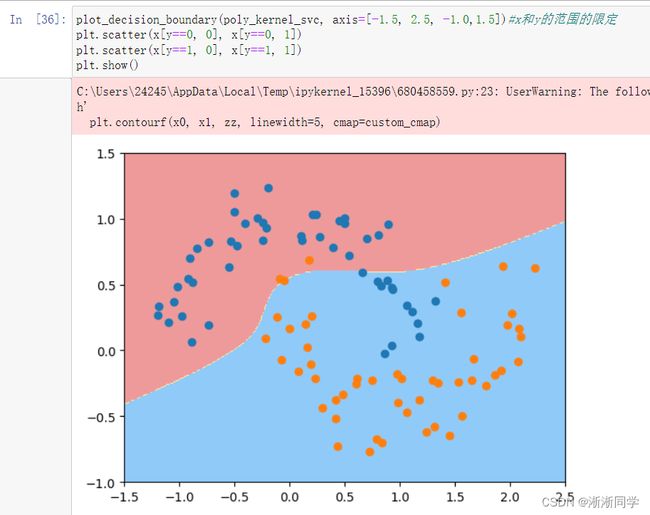文章目录
- 一、SVM中使用多项式特征
- 二、使用多项式核函数的SVM
一、SVM中使用多项式特征
import numpy as np
import matplotlib.pyplot as plt//////from sklearn import datasets
x,y=datasets.make_moons()
plt.scatter(x[y==1,0],x[y==1,1])
plt.show()

x,y=datasets.make_moons(noise=0.15,random_state=666)
plt.scatter(x[y==0,0],x[y==0,1])
plt.scatter(x[y==1,0],x[y==1,1])
plt.show()

from sklearn.preprocessing import PolynomialFeatures,StandardScaler
from sklearn.svm import LinearSVC
from sklearn.pipeline import Pipeline
def PolynomialSVC(degree,C=1.0):
return Pipeline(
[
("poly",PolynomialFeatures(degree=degree)),
("std_scaler",StandardScaler()),
("linearSVC",LinearSVC(C=C))
]
)
poly_svc=PolynomialSVC(degree=3)
poly_svc.fit(x,y)
def plot_decision_boundary(model, axis):
x0, x1 = np.meshgrid(
np.linspace(axis[0], axis[1], int((axis[1]-axis[0])*100)).reshape(-1,1),
np.linspace(axis[2], axis[3], int((axis[3]-axis[2])*100)).reshape(-1,1)
)
x_new = np.c_[x0.ravel(), x1.ravel()]
y_predict = model.predict(x_new)
zz = y_predict.reshape(x0.shape)
from matplotlib.colors import ListedColormap
custom_cmap = ListedColormap(['#EF9A9A','#FFF59D','#90CAF9'])
plt.contourf(x0, x1, zz, linewidth=5, cmap=custom_cmap)
plot_decision_boundary(poly_svc, axis=[-1.5, 2.5, -1.0,1.5])
plt.scatter(x[y==0, 0], x[y==0, 1])
plt.scatter(x[y==1, 0], x[y==1, 1])
plt.show()

二、使用多项式核函数的SVM
from sklearn.svm import SVC
def PolynomialKernelSVC(degree,C=1.0):
return Pipeline(
[
("std_scaler",StandardScaler()),
("kernelSVC",SVC(kernel="poly",degree=degree,C=C))
])
poly_kernel_svc=PolynomialKernelSVC(degree=3)
poly_kernel_svc.fit(x,y)
plot_decision_boundary(poly_kernel_svc, axis=[-1.5, 2.5, -1.0,1.5])
plt.scatter(x[y==0, 0], x[y==0, 1])
plt.scatter(x[y==1, 0], x[y==1, 1])
plt.show()




